Chenhui Li
IFDECORATOR: Wrapping Instruction Following Reinforcement Learning with Verifiable Rewards
Aug 06, 2025Abstract:Reinforcement Learning with Verifiable Rewards (RLVR) improves instruction following capabilities of large language models (LLMs), but suffers from training inefficiency due to inadequate difficulty assessment. Moreover, RLVR is prone to over-optimization, where LLMs exploit verification shortcuts without aligning to the actual intent of user instructions. We introduce Instruction Following Decorator (IFDecorator}, a framework that wraps RLVR training into a robust and sample-efficient pipeline. It consists of three components: (1) a cooperative-adversarial data flywheel that co-evolves instructions and hybrid verifications, generating progressively more challenging instruction-verification pairs; (2) IntentCheck, a bypass module enforcing intent alignment; and (3) trip wires, a diagnostic mechanism that detects reward hacking via trap instructions, which trigger and capture shortcut exploitation behaviors. Our Qwen2.5-32B-Instruct-IFDecorator achieves 87.43% accuracy on IFEval, outperforming larger proprietary models such as GPT-4o. Additionally, we demonstrate substantial improvements on FollowBench while preserving general capabilities. Our trip wires show significant reductions in reward hacking rates. We will release models, code, and data for future research.
Scientists' First Exam: Probing Cognitive Abilities of MLLM via Perception, Understanding, and Reasoning
Jun 12, 2025Abstract:Scientific discoveries increasingly rely on complex multimodal reasoning based on information-intensive scientific data and domain-specific expertise. Empowered by expert-level scientific benchmarks, scientific Multimodal Large Language Models (MLLMs) hold the potential to significantly enhance this discovery process in realistic workflows. However, current scientific benchmarks mostly focus on evaluating the knowledge understanding capabilities of MLLMs, leading to an inadequate assessment of their perception and reasoning abilities. To address this gap, we present the Scientists' First Exam (SFE) benchmark, designed to evaluate the scientific cognitive capacities of MLLMs through three interconnected levels: scientific signal perception, scientific attribute understanding, scientific comparative reasoning. Specifically, SFE comprises 830 expert-verified VQA pairs across three question types, spanning 66 multimodal tasks across five high-value disciplines. Extensive experiments reveal that current state-of-the-art GPT-o3 and InternVL-3 achieve only 34.08% and 26.52% on SFE, highlighting significant room for MLLMs to improve in scientific realms. We hope the insights obtained in SFE will facilitate further developments in AI-enhanced scientific discoveries.
Consensus Entropy: Harnessing Multi-VLM Agreement for Self-Verifying and Self-Improving OCR
Apr 16, 2025



Abstract:The Optical Character Recognition (OCR) task is important for evaluating Vision-Language Models (VLMs) and providing high-quality data sources for LLM training data. While state-of-the-art VLMs show improved average OCR accuracy, they still struggle with sample-level quality degradation and lack reliable automatic detection of low-quality outputs. We introduce Consensus Entropy (CE), a training-free post-inference method that quantifies OCR uncertainty by aggregating outputs from multiple VLMs. Our approach exploits a key insight: correct VLM OCR predictions converge in output space while errors diverge. We develop a lightweight multi-model framework that effectively identifies problematic samples, selects the best outputs and combines model strengths. Experiments across multiple OCR benchmarks and VLMs demonstrate that CE outperforms VLM-as-judge approaches and single-model baselines at the same cost and achieves state-of-the-art results across multiple metrics. For instance, our solution demonstrates: achieving 15.2% higher F1 scores than VLM-as-judge methods in quality verification, delivering 6.0% accuracy gains on mathematical calculation tasks, and requiring rephrasing only 7.3% of inputs while maintaining overall performance. Notably, the entire process requires neither training nor supervision while maintaining plug-and-play functionality throughout.
OpenFly: A Versatile Toolchain and Large-scale Benchmark for Aerial Vision-Language Navigation
Feb 25, 2025Abstract:Vision-Language Navigation (VLN) aims to guide agents through an environment by leveraging both language instructions and visual cues, playing a pivotal role in embodied AI. Indoor VLN has been extensively studied, whereas outdoor aerial VLN remains underexplored. The potential reason is that outdoor aerial view encompasses vast areas, making data collection more challenging, which results in a lack of benchmarks. To address this problem, we propose OpenFly, a platform comprising a versatile toolchain and large-scale benchmark for aerial VLN. Firstly, we develop a highly automated toolchain for data collection, enabling automatic point cloud acquisition, scene semantic segmentation, flight trajectory creation, and instruction generation. Secondly, based on the toolchain, we construct a large-scale aerial VLN dataset with 100k trajectories, covering diverse heights and lengths across 18 scenes. The corresponding visual data are generated using various rendering engines and advanced techniques, including Unreal Engine, GTA V, Google Earth, and 3D Gaussian Splatting (3D GS). All data exhibit high visual quality. Particularly, 3D GS supports real-to-sim rendering, further enhancing the realism of the dataset. Thirdly, we propose OpenFly-Agent, a keyframe-aware VLN model, which takes language instructions, current observations, and historical keyframes as input, and outputs flight actions directly. Extensive analyses and experiments are conducted, showcasing the superiority of our OpenFly platform and OpenFly-Agent. The toolchain, dataset, and codes will be open-sourced.
Open-Vocabulary Octree-Graph for 3D Scene Understanding
Nov 25, 2024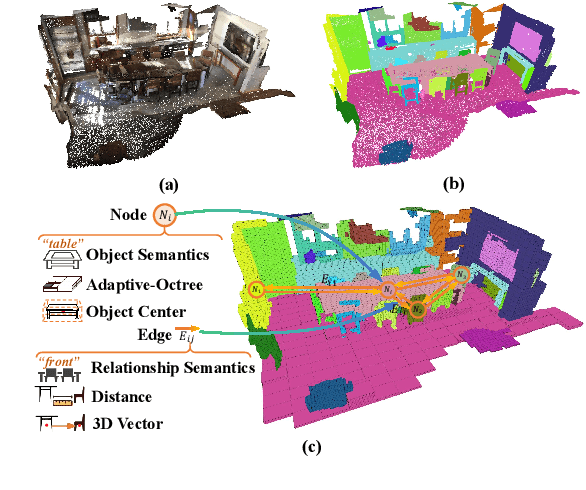
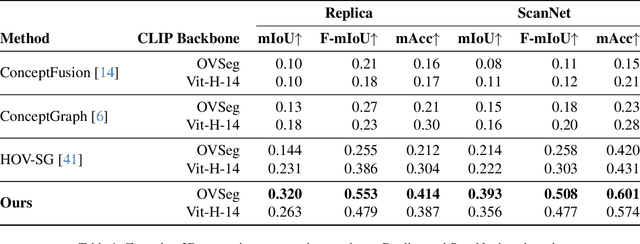
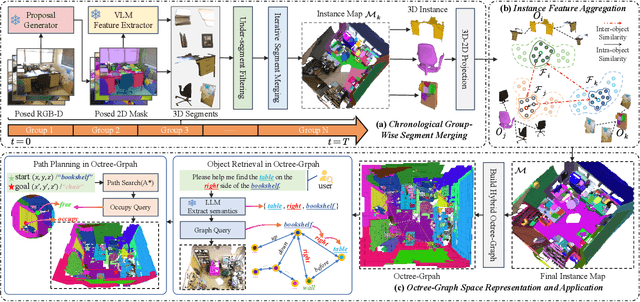
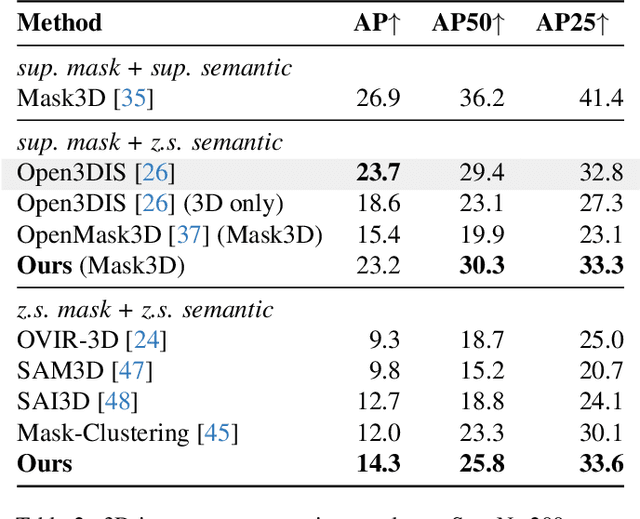
Abstract:Open-vocabulary 3D scene understanding is indispensable for embodied agents. Recent works leverage pretrained vision-language models (VLMs) for object segmentation and project them to point clouds to build 3D maps. Despite progress, a point cloud is a set of unordered coordinates that requires substantial storage space and does not directly convey occupancy information or spatial relation, making existing methods inefficient for downstream tasks, e.g., path planning and complex text-based object retrieval. To address these issues, we propose Octree-Graph, a novel scene representation for open-vocabulary 3D scene understanding. Specifically, a Chronological Group-wise Segment Merging (CGSM) strategy and an Instance Feature Aggregation (IFA) algorithm are first designed to get 3D instances and corresponding semantic features. Subsequently, an adaptive-octree structure is developed that stores semantics and depicts the occupancy of an object adjustably according to its shape. Finally, the Octree-Graph is constructed where each adaptive-octree acts as a graph node, and edges describe the spatial relations among nodes. Extensive experiments on various tasks are conducted on several widely-used datasets, demonstrating the versatility and effectiveness of our method.
ChatTracker: Enhancing Visual Tracking Performance via Chatting with Multimodal Large Language Model
Nov 04, 2024



Abstract:Visual object tracking aims to locate a targeted object in a video sequence based on an initial bounding box. Recently, Vision-Language~(VL) trackers have proposed to utilize additional natural language descriptions to enhance versatility in various applications. However, VL trackers are still inferior to State-of-The-Art (SoTA) visual trackers in terms of tracking performance. We found that this inferiority primarily results from their heavy reliance on manual textual annotations, which include the frequent provision of ambiguous language descriptions. In this paper, we propose ChatTracker to leverage the wealth of world knowledge in the Multimodal Large Language Model (MLLM) to generate high-quality language descriptions and enhance tracking performance. To this end, we propose a novel reflection-based prompt optimization module to iteratively refine the ambiguous and inaccurate descriptions of the target with tracking feedback. To further utilize semantic information produced by MLLM, a simple yet effective VL tracking framework is proposed and can be easily integrated as a plug-and-play module to boost the performance of both VL and visual trackers. Experimental results show that our proposed ChatTracker achieves a performance comparable to existing methods.
PPRSteg: Printing and Photography Robust QR Code Steganography via Attention Flow-Based Model
May 26, 2024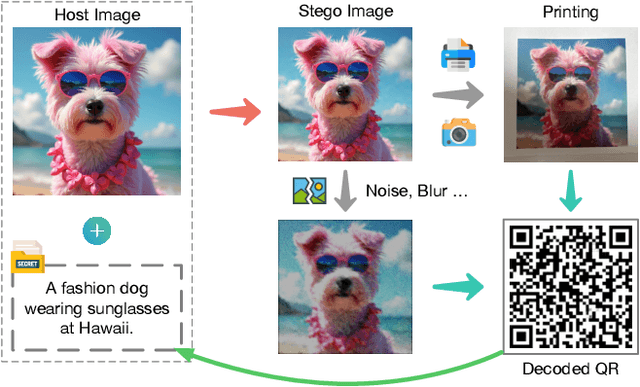
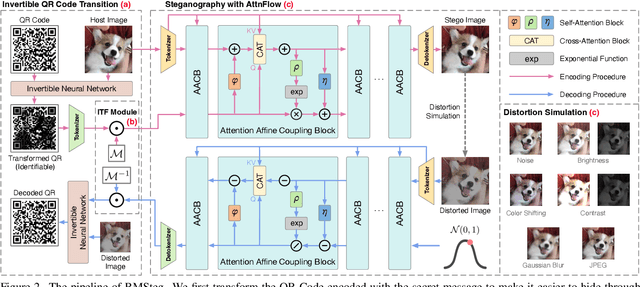

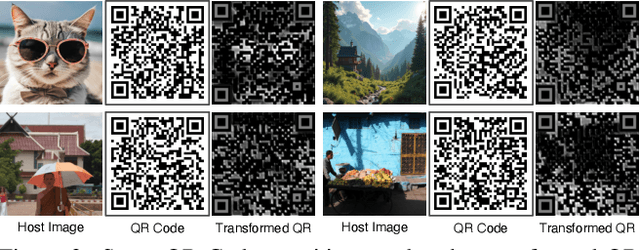
Abstract:Image steganography can hide information in a host image and obtain a stego image that is perceptually indistinguishable from the original one. This technique has tremendous potential in scenarios like copyright protection, information retrospection, etc. Some previous studies have proposed to enhance the robustness of the methods against image disturbances to increase their applicability. However, they generally cannot achieve a satisfying balance between the steganography quality and robustness. In this paper, we focus on the issue of QR Code steganography that is robust to real-world printing and photography. Different from common image steganography, QR Code steganography aims to embed a non-natural image into a natural image and the restored QR Code is required to be recognizable, which increases the difficulty of data concealing and revealing. Inspired by the recent developments in transformer-based vision models, we discover that the tokenized representation of images is naturally suitable for steganography. In this paper, we propose a novel QR Code embedding framework, called Printing and Photography Robust Steganography (PPRSteg), which is competent to hide QR Code in a host image with unperceivable changes and can restore it even if the stego image is printed out and photoed. We outline a transition process to reduce the artifacts in stego images brought by QR Codes. We also propose a steganography model based on normalizing flow, which combines the attention mechanism to enhance its performance. To our best knowledge, this is the first work that integrates the advantages of transformer models into normalizing flow. We conduct comprehensive and detailed experiments to demonstrate the effectiveness of our method and the result shows that PPRSteg has great potential in robust, secure and high-quality QR Code steganography.
TextCenGen: Attention-Guided Text-Centric Background Adaptation for Text-to-Image Generation
Apr 18, 2024Abstract:Recent advancements in Text-to-image (T2I) generation have witnessed a shift from adapting text to fixed backgrounds to creating images around text. Traditional approaches are often limited to generate layouts within static images for effective text placement. Our proposed approach, TextCenGen, introduces a dynamic adaptation of the blank region for text-friendly image generation, emphasizing text-centric design and visual harmony generation. Our method employs force-directed attention guidance in T2I models to generate images that strategically reserve whitespace for pre-defined text areas, even for text or icons at the golden ratio. Observing how cross-attention maps affect object placement, we detect and repel conflicting objects using a force-directed graph approach, combined with a Spatial Excluding Cross-Attention Constraint for smooth attention in whitespace areas. As a novel task in graphic design, experiments indicate that TextCenGen outperforms existing methods with more harmonious compositions. Furthermore, our method significantly enhances T2I model outcomes on our specially collected prompt datasets, catering to varied text positions. These results demonstrate the efficacy of TextCenGen in creating more harmonious and integrated text-image compositions.
AACP: Aesthetics assessment of children's paintings based on self-supervised learning
Mar 12, 2024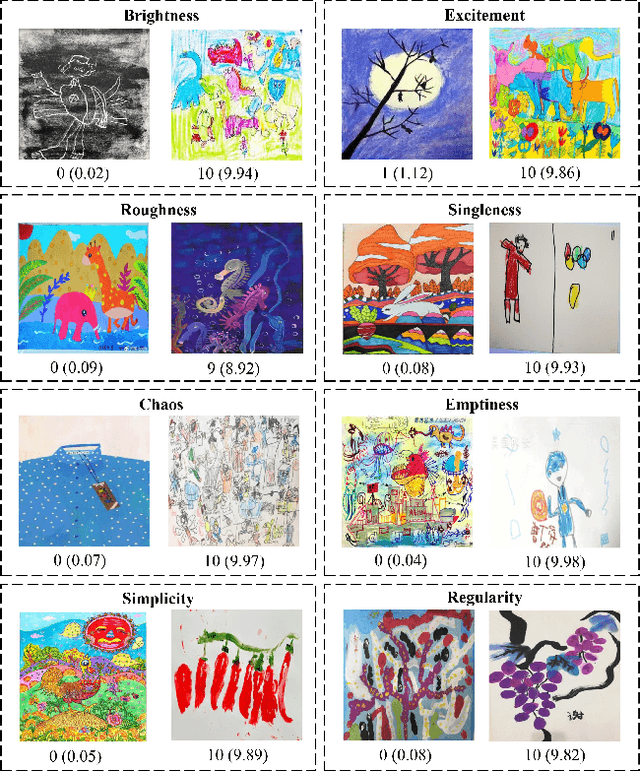
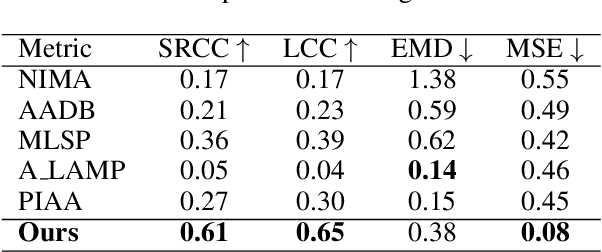

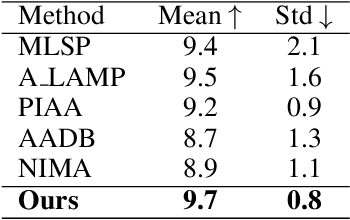
Abstract:The Aesthetics Assessment of Children's Paintings (AACP) is an important branch of the image aesthetics assessment (IAA), playing a significant role in children's education. This task presents unique challenges, such as limited available data and the requirement for evaluation metrics from multiple perspectives. However, previous approaches have relied on training large datasets and subsequently providing an aesthetics score to the image, which is not applicable to AACP. To solve this problem, we construct an aesthetics assessment dataset of children's paintings and a model based on self-supervised learning. 1) We build a novel dataset composed of two parts: the first part contains more than 20k unlabeled images of children's paintings; the second part contains 1.2k images of children's paintings, and each image contains eight attributes labeled by multiple design experts. 2) We design a pipeline that includes a feature extraction module, perception modules and a disentangled evaluation module. 3) We conduct both qualitative and quantitative experiments to compare our model's performance with five other methods using the AACP dataset. Our experiments reveal that our method can accurately capture aesthetic features and achieve state-of-the-art performance.
SalienTime: User-driven Selection of Salient Time Steps for Large-Scale Geospatial Data Visualization
Mar 06, 2024



Abstract:The voluminous nature of geospatial temporal data from physical monitors and simulation models poses challenges to efficient data access, often resulting in cumbersome temporal selection experiences in web-based data portals. Thus, selecting a subset of time steps for prioritized visualization and pre-loading is highly desirable. Addressing this issue, this paper establishes a multifaceted definition of salient time steps via extensive need-finding studies with domain experts to understand their workflows. Building on this, we propose a novel approach that leverages autoencoders and dynamic programming to facilitate user-driven temporal selections. Structural features, statistical variations, and distance penalties are incorporated to make more flexible selections. User-specified priorities, spatial regions, and aggregations are used to combine different perspectives. We design and implement a web-based interface to enable efficient and context-aware selection of time steps and evaluate its efficacy and usability through case studies, quantitative evaluations, and expert interviews.
 Add to Chrome
Add to Chrome Add to Firefox
Add to Firefox Add to Edge
Add to Edge